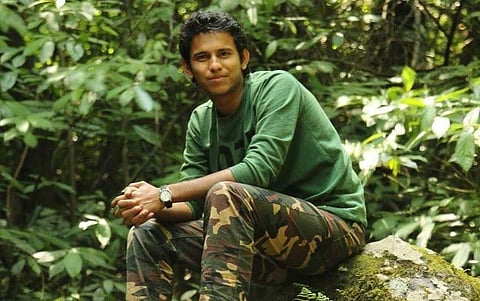

Birdwatching is a rather interesting activity as you get to see different kinds of birds but it isn't as laidback as it sounds. It requires patience to spot a bird and then study about it. Mastering this patience is Kiran Bagade, one of the few birdwatchers in Karnataka. After completing his Master's in Development Management from Mysore University, Kiran pursued an online course in Ornithology from Bombay Natural History Society (BNHS).
But before he took up this course, he was already an avid birdwatcher for four years along with his uncle. "The course is a mixture of practical and theoretical classes. There are regular assignments where we get to study about different species, migration etc. There are also trips to a bio-diversity park, a lake or a tiger reserve in search of different species to watch and gain knowledge about. Apart from this, we are given the opportunity to interact with the locals to educate them about the birds, conservation of habitat, food and how special they are to this particular place," says Kiran.
BNHS also conducts five different camps for birdwatching out of which Kiran attended three — Mumbai, Solapur and Point Calimere in Tamil Nadu. It is during these camps that Kiran learnt the process of bird ringing. He says, "Bird ringing is the process of capturing birds and fixing a ring around their feet or any part of their body. Usually, these rings have a code written on them. Whenever these birds migrate from one place to another place, the ornithologists capture their movements and study them. Through this, they learn about their migration pattern, breeding season and much more. In other countries, there are not many restrictions on bird ringing whereas in India, there are certain rules and restrictions. This process is allowed only in two places including Point Calimere and Lake Chilika and all the details of all these birds are well documented."
Kiran, who runs an organisation called Aranya Outreach, also conducts trekking camps for adults and birdwatching sessions for kids. He holds sessions in Mysuru and Bengaluru. But for him, it is not the destination that matters. Creating awareness among people about the importance of birds to the ecology is what matters, "Whenever we take students out for bird watching, identification is an important factor we teach them and the species of birds found in particular places. The second factor includes telling students that birds are important for balance in the ecology, seed dispersal and pollination. And the last part is about the migration of birds. Generally, people think that birds migrate as other regions are colder than India. But the fact is that they come in search of food as it is majorly covered in snow. So we are staying the Central Asian migratory region and a large number of birds come from the Northern part of Russia, Eurasia and Europe.
Like most of us, Kiran also believes that global warming and climate change are true. He says, "By educating children and sowing the seed of protecting the environment through birdwatching, we can create a sense of belongingness. They might not develop bird watching as a hobby but they will educate others and protect the environment from being destroyed."
Kiran's favourite birdwatching spots including Nal Pari Lake, Dal Lake and Rann of Kutch, Arunachal Pradesh and North East. While Gujarat mostly has wetland species like flamingos, all kinds of ducks migrate from Eurasia and other birds that are found in semi-arid regions. The northeast is covered with rain forests and one can see colourful birds here. Telling us the kind of interesting facts kids can learn through bird watching, Kiran says, "Let's take the example of the black drongo. Though it is a small bird, it isn't scared of predators like eagles or vultures. As they scare these predators away by mimicking their sounds, most other birds find it safer to build their nests near the black drongo. Children will learn interesting facts like these they would otherwise not come across within the four walls of a classroom."
With his many years of experience, Kiran has captured photos of a bird called the bar-headed goose which is one of the highest-flying birds in the world. It migrates to India from Mongolia and China. They also breed in the foothills of the Himalayas and Ladakh. "The bird in my photograph had a ring around its neck that was done by ornithologists in Mongolia. I wrote a letter to them to find out all the details of the bird," says the young man who has seen around 500 species of birds throughout India and has photographed around 200 species. Kiran had set up his first photo exhibition in his native town of Nanjangud near Mysuru and has also collaborated with a few like-minded people to hold more such exhibitions. He has now taken a break to prepare for his UPSC exams as he aims to form policies that are in favour of saving the environment.
Kiran's guide to hosting a birdwatching session for kids:
* Give kids binoculars or a spotting scope, if necessary, for them to observe the birds closely
* Keep it simple for kids, 'simple' referring to the identification of birds like sparrows, pigeons etc
* Once they get the hang of it, tell them about more such birds
* Ensure that, while observing the birds, the kids keep silent so as to not scare them away
* Later, educate the kids on the relevance of birdwatching and studying environmental science at the same time
